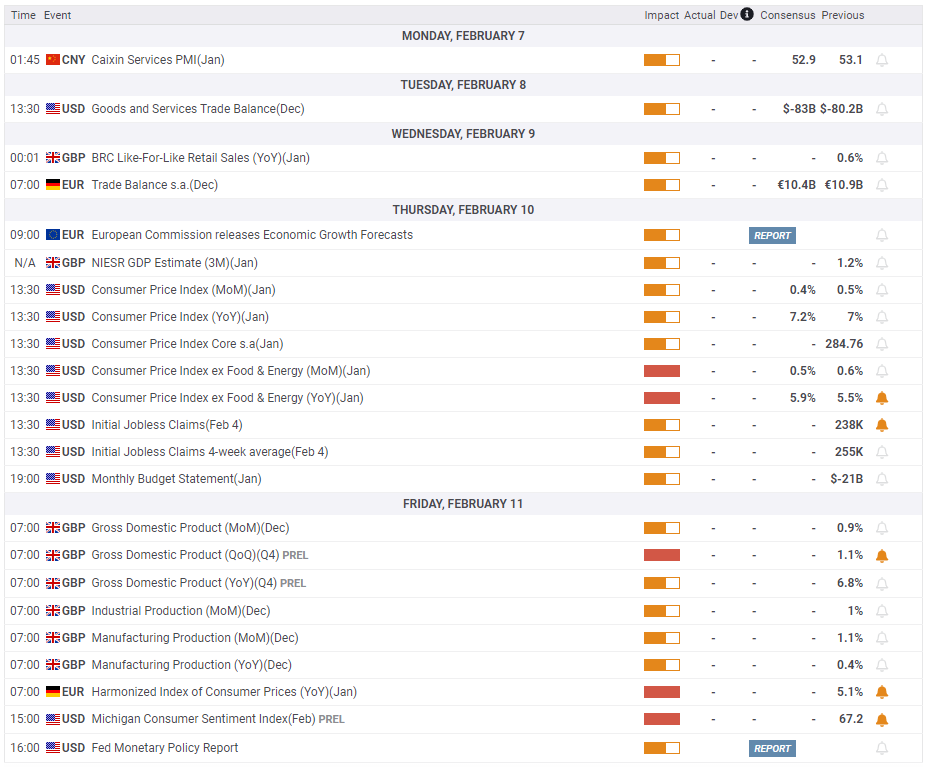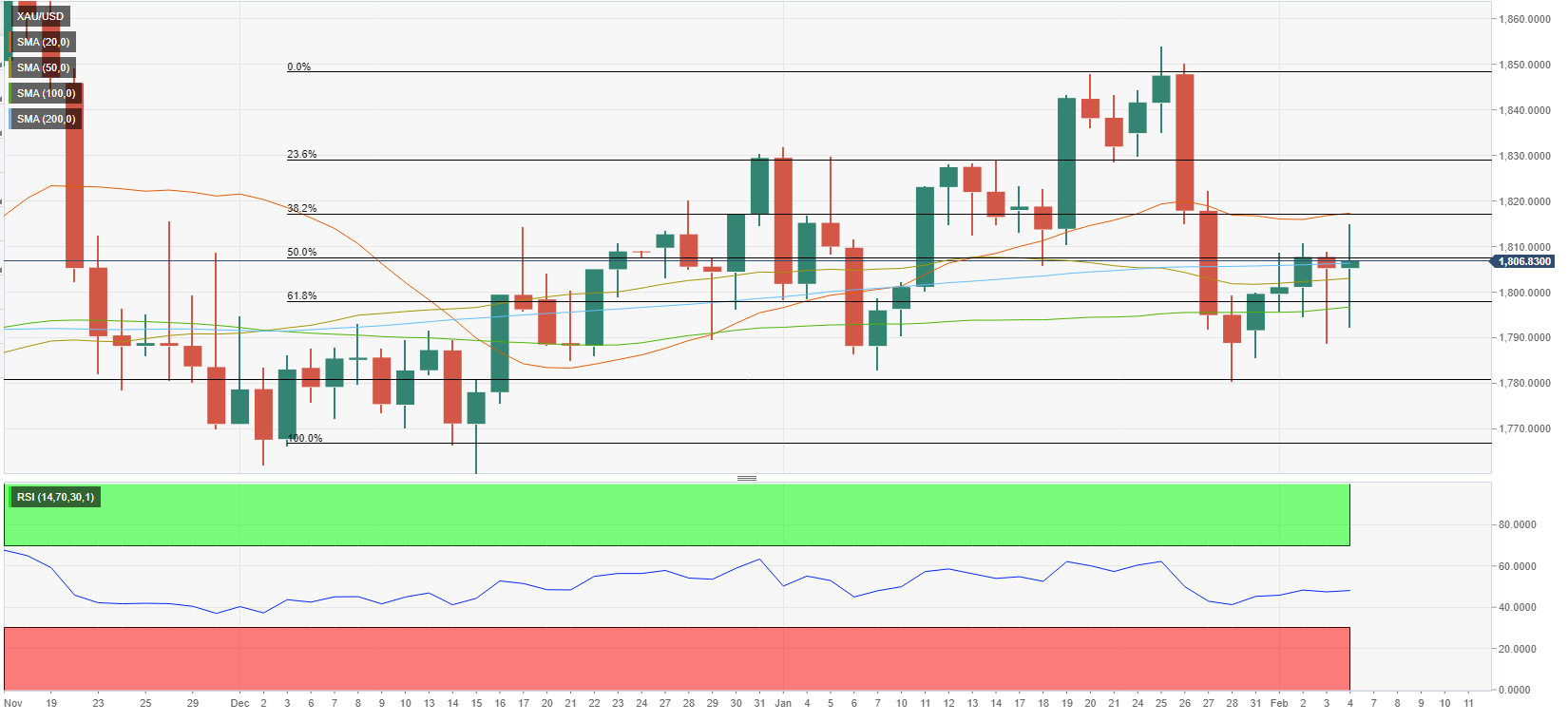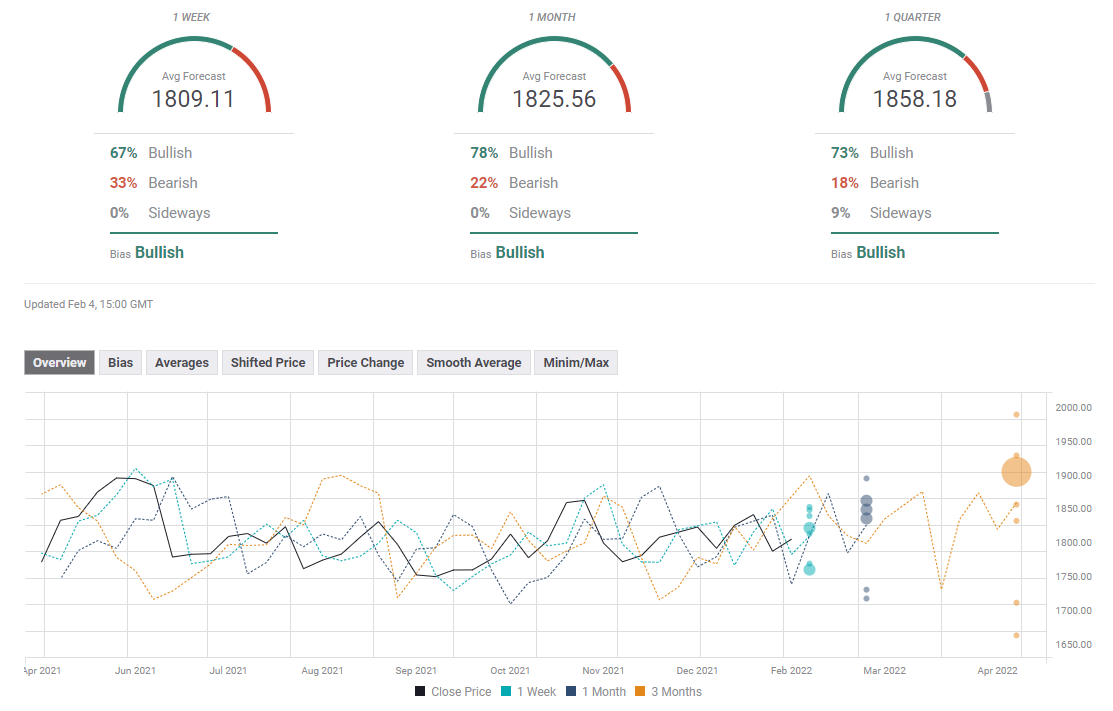- Gold registered small weekly gains but struggled to make a decisive move.
- Dollar shook off the bearish pressure after January jobs report.
- Next week's US CPI data could trigger a big reaction in XAU/USD.
Following the previous week’s sharp decline, gold managed to stage a rebound during the first half of the week with the dollar struggling to find demand. Rising US Treasury bond yields capped XAU/USD’s upside on Thursday and the upbeat January jobs report from the US didn't allow the pair to gather bullish momentum. Gold is likely to remain inversely correlated with the benchmark 10-year US T-bond yield next week as investors will await the US January Consumer Price Index (CPI) data, which could impact the market odds of a 50 basis points (bps) Fed rate hike in March.
What happened last week
The positive shift witnessed in market sentiment made it difficult for the greenback to find demand on Monday. Reflecting the improving mood, the S&P 500 Index rose nearly 2% on Monday. Moreover, several FOMC policymakers voiced their support for a 25 bps rate increase in March while noting a bigger hike was unlikely.
On Tuesday, the data from the US showed that the economic activity in the manufacturing sector continued to expand at a robust pace in January. The dollar stayed on the back foot with Wall Street’s main indexes continuing to push higher and gold climbing above $1,800.
The dollar sell-off stayed intact on Wednesday after the ADP reported that the employment in the private sector declined by 301,000 in January, reviving concerns over worsening conditions in the US labour market. XAU/USD closed the third straight day in positive territory and stayed relatively quiet early Thursday with investors moving to the sidelines while awaiting the Bank of England’s (BOE) and the European Central Bank’s (ECB) policy announcements.
The BOE hiked its policy rate by 25 bps to 0.5% following the February policy meeting. The policy statement revealed that four members of the Monetary Policy Committee voted for a 50 bps rate hike. With the initial reaction, GBP/USD surged higher and the lack of demand for the dollar allowed XAU/USD to cling to its weekly gains.
ECB President Christine Lagarde’s surprisingly hawkish remarks, however, triggered a rally in global bond yields and forced gold to lose its traction.
Lagarde did not repeat her previous comment that interest rates were not likely to increase in 2022 when asked about it. Additionally, she acknowledged that inflation in the euro was seen staying high for longer than expected. Despite the heavy selling pressure surrounding the dollar, gold snapped a three-day winning streak on Thursday, pressured by a 3% increase in the benchmark 10-year US T-bond yield.
On Friday, the US Bureau of Labor Statistics (BLS) announced that Nonfarm Payrolls increased by 467,000 in January, surpassing the market expectation of 150,000. Additionally, the December print got revised higher to 510,000 from 199,000. Underlying details of the jobs report showed that annual wage inflation climbed to 5.7% from 5% and the Labor Force Participation rate improved to 62.2% from 61.9%. The US Dollar Index edged higher after the data and the 10-year US T-bond yield rose to 1.9%, causing gold to return to the $1,800 area.
Next week
There won’t be any high-tier data releases in the first half of next week. The inverse correlation with US Treasury bond yields is likely to continue to impact the precious metal’s valuation. With major central banks turning more hawkish than anticipated to battle inflation, global bond yields are likely to continue to edge higher.
On Thursday, the US Bureau of Labor Statistics will release the January Consumer Price Index (CPI) data. On a yearly basis, the CPI is forecast to rise to 7.2% from 7% in December. A stronger-than-expected reading could ramp up the probability of a 50 bps hike in March, which currently stands at 25% according to the CME Group FedWatch Tool – and weigh on XAU/USD.
Ahead of the weekend, the Fed will submit its semi-annual Monetary Policy Report to the Senate Committee on Banking, Housing, and Urban Affairs. Market participants will look for fresh clues on the rate outlook and the timing of balance sheet reduction.
Gold technical outlook
Gold's technical outlook shows that the yellow metal is struggling to make a decisive move in either direction. The Relative Strength Index (RSI) indicator on the daily chart is moving sideways around 50 and the pair is trading near the 200-day SMA while holding above the 100-day SMA.
In case the price stays above $1,805 (200-day SMA) and starts using this level as support, the next target on the upside is located at $1,820 (20-day SMA, Fibonacci 38.2% retracement of December-February uptrend) before $1,830 (Fibonacci 23.6% retracement).
In case $1,805 is confirmed as resistance, gold needs to make a daily close below $1,800 (100-day SMA, Fibonacci 61.8% retracement) to convince bears. In that case, $1,780 (static level) aligns as the next support.
Gold sentiment poll
The FXStreet Forecast Poll shows that gold's bullish bias is unchanged in the near term but the one-week target of $1,809 suggests that there isn't a lot of room on the upside.
Information on these pages contains forward-looking statements that involve risks and uncertainties. Markets and instruments profiled on this page are for informational purposes only and should not in any way come across as a recommendation to buy or sell in these assets. You should do your own thorough research before making any investment decisions. FXStreet does not in any way guarantee that this information is free from mistakes, errors, or material misstatements. It also does not guarantee that this information is of a timely nature. Investing in Open Markets involves a great deal of risk, including the loss of all or a portion of your investment, as well as emotional distress. All risks, losses and costs associated with investing, including total loss of principal, are your responsibility. The views and opinions expressed in this article are those of the authors and do not necessarily reflect the official policy or position of FXStreet nor its advertisers. The author will not be held responsible for information that is found at the end of links posted on this page.
If not otherwise explicitly mentioned in the body of the article, at the time of writing, the author has no position in any stock mentioned in this article and no business relationship with any company mentioned. The author has not received compensation for writing this article, other than from FXStreet.
FXStreet and the author do not provide personalized recommendations. The author makes no representations as to the accuracy, completeness, or suitability of this information. FXStreet and the author will not be liable for any errors, omissions or any losses, injuries or damages arising from this information and its display or use. Errors and omissions excepted.
The author and FXStreet are not registered investment advisors and nothing in this article is intended to be investment advice.
Recommended Content
Editors’ Picks

EUR/USD stabilizes above 1.1350 on Easter Friday
EUR/USD enters a consolidation phase above 1.1350 on Friday as the trading action remains subdued, with major markets remaining closed in observance of the Easter Holiday. On Thursday, the European Central Bank (ECB) announced it cut key rates by 25 bps, as expected.

GBP/USD fluctuates below 1.3300, looks to post weekly gains
After setting a new multi-month high near 1.3300 earlier in the week, GBP/USD trades in a narrow band at around 1.32700 on Friday and remains on track to end the week in positive territory. Markets turn quiet on Friday as trading conditions thin out on Easter Holiday.

Gold ends week with impressive gains above $3,300
Gold retreated slightly from the all-time high it touched at $3,357 early Thursday but still gained more than 2% for the week after settling at $3,327. The uncertainty surrounding US-China trade relations caused markets to adopt a cautious stance, boosting safe-haven demand for Gold.

How SEC-Ripple case and ETF prospects could shape XRP’s future
Ripple consolidated above the pivotal $2.00 level while trading at $2.05 at the time of writing on Friday, reflecting neutral sentiment across the crypto market.

Future-proofing portfolios: A playbook for tariff and recession risks
It does seem like we will be talking tariffs for a while. And if tariffs stay — in some shape or form — even after negotiations, we’ll likely be talking about recession too. Higher input costs, persistent inflation, and tighter monetary policy are already weighing on global growth.

The Best brokers to trade EUR/USD
SPONSORED Discover the top brokers for trading EUR/USD in 2025. Our list features brokers with competitive spreads, fast execution, and powerful platforms. Whether you're a beginner or an expert, find the right partner to navigate the dynamic Forex market.



